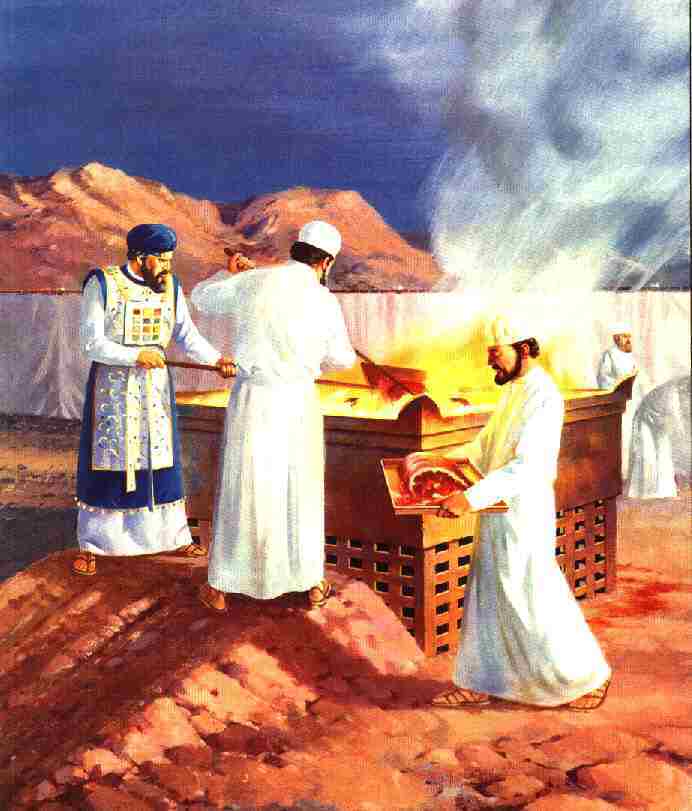THE DAY OF ATONEMENT is a solemn fast day observed on Tishri 10 (Leviticus 23:32). To keep it properly one must refrain from work and cleanse oneself from sin (Leviticus 16:30). It ends the Ten Days of Penitence. In biblical times the high priest entered the Holy of Holies dressed in white linen. He offered sacrifices as a sin covering for himself, for the other Levites and for the people. It was also a time for cleansing the tabernacle or the later temples from the polluting effects of sin.
The Atonement Day was a time of holy convention and of fasting, as is indicated by the fact that the people were then to "afflict their souls." This was the only fast enjoined under the Mosaic Law.

On this day the high priest set aside his regular priestly garb, bathed in water, and dressed himself in holy linen garments (Leviticus 16:4). Lots were next drawn by the high priest over two goats that were exactly alike in their sound and unblemished condition, these having been obtained from the assembly of the sons of Israel (Leviticus 16:5, 7). The high priest drew lots over them to determine which of the two would be sacrificed to YEHOVAH God as a sin offering and which would be released into the wilderness -- bearing their sins as the "goat for Azazel" (Leviticus 16:8, 9; compare 14:1-7).
The goat on which the lot fell "for God" was sacrificed as a sin offering for the people (Leviticus 16:8-10). The high priest then took the blood of the goat for YEHOVAH God into the Holy of Holies, using it there to make atonement for the 12 nonpriestly tribes of Israel. In a manner similar to the handling of the bull's blood, the blood of the goat was sprinkled "toward the cover and before the cover" of the Ark (Leviticus 16:15).
The high priest now turned his attention to the remaining goat -- the one for Azazel. He laid his hands upon its head, confessed over it "all the errors of the sons of Israel and all their revolts in all their sins," put these upon its head, and then sent it away "by the hand of a ready man into the wilderness." Thus, the goat carried the errors of the Israelites into the wilderness, where it disappeared (Leviticus 16: 20-22). Thereafter the man who led the goat away had to wash his garments and bathe his flesh in water before re-entering the camp.
By these means the high priest also made atonement for the holy place and the tent of the meeting in the times before the temples. Then, taking some of the blood of the bull and of the "goat for God," he made atonement for the altar of burnt offering, putting some of such blood upon the horns of the altar. He was also to "splatter some of the blood upon it with his finger seven times and cleanse it and sanctify it from the uncleannesses of the sons of Israel."
In his letter to the Hebrews, Paul shows that Yeshua the Messiah is the great antitypical High Priest (Hebrews 5:4-10). The apostle also indicates that the high priest's entry into the Holy of Holies one day a year with the blood of sacrificial animals foreshadowed the entrance of Yeshua the Messiah into heaven itself with his own blood, thus to make atonement for those exercising faith in His sacrifice. Of course, Yeshua, being sinless, did not have to offer sacrifice for any personal sins, as did Israel's high priest.

The annual Day of Atonement, like other features of the Mosaic Law, served as a picture of something far greater. Careful examintion of this observance in the light of the apostle Paul's inspired remarks shows that Yeshua the Messiah and His redemptive work in behalf of mankind were typified by Israel's high priest and by the animals used in connection with the ceremony.
It is evident
that, while the Day of Atonement prior to the establishment of YEHOVAH
God's Church did not produce complete and permanent removal of sin even
for Israel, the various features of that annual celebration were typical
in character. They foreshadowed the grand atonement made for sins by Yeshua
the Messiah -- our High Priest and Elder Brother.